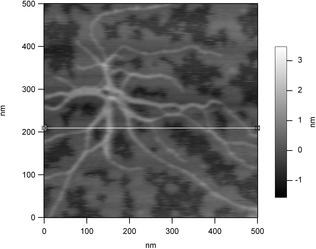|
|
|
|
|
|
 | |
Biological applications of atomic force microscopy |
Principal Investigator: György Váró
The application of antisense oligonucleotides (ODN) modulating gene expression is a promising approach of medicinal therapeutics. The major limitation of non-viral gene delivery systems is the low efficiency of membrane translocation and targeting. To become effective, transfected genes require delivery into the nucleus. The complexes formed by Pal SV modified nuclear localization signal peptide and 18 mer oligonucleotide at different concentrations were studied.
The peptides appear on the AFM images as randomly spread 0.4 ± 0.1 nm high spots. Clean surface of mica are distinguishable, proving that such concentration of peptide was convenient for AFM studies.
The oligonucleotides dried on the mica surface presented around 1 µm long fibrous structures, with an average height of 1.2 ± 0.3 nm. In most cases they overlapped and formed network.
In the case of molar ratio of 20, the ODN fibers were coated by the peptide. Due to the strong electrostatic interaction between the peptides and ODNs, the complex could be visualized even in the case of highly diluted samples used for AFM studies.

Peptides covering the fiber-like oligonucleotide structures. 500 x 500 nm2 AC mode scan.
Reference:
Laczkó I., G. Váró, S. Bottka, Z. Bálint, E. Illyés, E. Vass, J.-R. Bertrand, C. Malvy and M. Hollósi. 2006. N-Terminal acylation of the
SV40 nuclear localization signal peptide enhances its oligonucleotide binding and membrane translocation efficiencies. Archives of
Biochemistry and Biophysics. 454 (2):146-154.
| |

